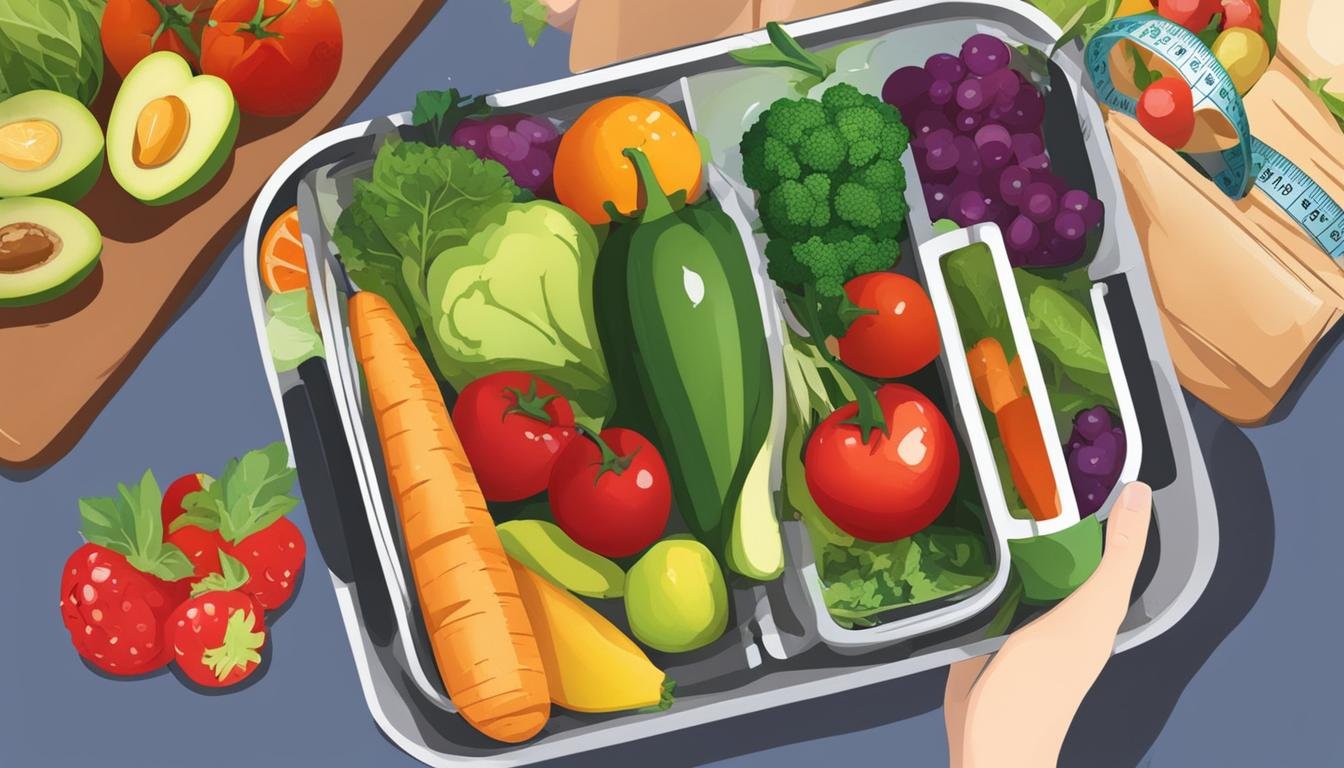Are you struggling to stay on track with your weight loss journey? Don’t worry, we’ve got you covered. Losing weight and keeping it off can be a challenging task, but with the right strategies, you can achieve your goals and maintain a healthy weight for the long term. In this article, we will share 10 effective tips to help you stay on track with your weight loss journey.
Key Takeaways:
- Make gradual, permanent lifestyle changes instead of relying on crash diets.
- Eat a variety of colorful, nutritionally dense foods, focusing on fruits, vegetables, whole grains, and lean proteins.
- Keep a food and weight diary to hold yourself accountable and track your progress.
- Engage in regular physical activity and exercise, aiming for at least one hour of moderate-intensity activity per day.
- Avoid consuming liquid calories and opt for water or unsweetened beverages instead.
Eat Varied, Colorful, Nutritionally Dense Foods
When it comes to maintaining a healthy weight, the food you eat plays a crucial role. By incorporating varied, colorful, and nutritionally dense foods into your diet, you can support your weight loss journey and improve your overall well-being.
An effective way to ensure a balanced diet is to create a meal plan that includes a good balance of different food groups. Aim for 50% of your plate to be filled with fruits and vegetables, 25% with whole grains, and the remaining 25% with protein sources such as lean meats, poultry, fish, or plant-based alternatives.
Additionally, it’s important to pay attention to your fiber intake. Aim for a total daily intake of 25-30 grams of fiber, as it can help you feel fuller for longer and support healthy digestion. Fiber-rich foods include fruits, vegetables, legumes, nuts, and whole grains. These foods not only provide essential nutrients but also contribute to a well-rounded and satisfying meal.
Create a Beautiful Table Here, showcasing food groups and their benefits
| Food Group | Benefits |
|---|---|
| Fruits and Vegetables | Rich in vitamins, minerals, and antioxidants |
| Whole Grains | Provide fiber and essential nutrients |
| Protein sources | Support muscle growth and repair |
To further enhance the nutritional value of your meals, it’s important to make mindful choices when it comes to fats. Avoid trans fats and minimize saturated fats found in foods like butter, high-fat dairy products, and fatty meats. Instead, opt for healthier fats such as monounsaturated or polyunsaturated fatty acids, which can be found in foods like avocados, olive oil, and fatty fish.
By focusing on eating varied, colorful, and nutritionally dense foods, you can create healthy meals that not only support your weight loss journey but also provide you with the essential nutrients your body needs to thrive.
Keep a Food and Weight Diary
One effective strategy for staying on track with your weight loss journey is to keep a food and weight diary. This self-monitoring practice helps you stay accountable and measure your progress. By maintaining a record of everything you eat, you become more aware of your eating habits and can make adjustments as needed. You can use a paper diary, a mobile app, or a website to document your meals and snacks throughout the day. Not only does this help you track your calorie intake, but it also provides insight into your eating patterns and any emotional triggers that may be contributing to overeating.
In addition to logging your food intake, it’s also beneficial to include your weight in the diary on a weekly basis. This allows you to track your body mass index (BMI) and see your progress over time. By recording both your food choices and changes in your weight, you can identify any connections between your eating habits and weight fluctuations. This self-awareness can help you make more informed decisions about your diet and exercise routine.
Table: Sample Food and Weight Diary
| Date | Food and Beverage Intake | Calories | Weight |
|---|---|---|---|
| Monday |
|
1500 | 160 lbs |
| Tuesday |
|
1400 | 158 lbs |
| Wednesday |
|
1600 | 157 lbs |
By consistently keeping a food and weight diary, you can better understand the impact of your dietary choices on your weight loss progress. This practice promotes self-awareness, accountability, and helps you make more informed decisions about your diet and exercise routine.
Engage in Regular Physical Activity and Exercise
Physical activity and exercise play a crucial role in achieving and maintaining weight loss. Regular exercise not only helps burn calories but also boosts your metabolism, builds lean muscle mass, and improves overall fitness. Incorporating physical activity into your daily routine is essential for long-term success on your weight loss journey.
When it comes to physical activity, aim for at least one hour of moderate-intensity activity per day. This can include activities like brisk walking, cycling, swimming, or dancing. If you’re unable to dedicate a full hour at once, aim for a minimum of 150 minutes of exercise each week. Gradually increase the frequency and intensity of your workouts as your fitness level improves.
Tracking your calorie balance can be helpful in maintaining the right energy expenditure for weight loss. There are mobile apps available that can help you monitor your calorie intake and expenditure, making it easier to stay on track. Start by incorporating simple activities into your daily routine, such as taking the stairs instead of the elevator, walking or biking to work, or playing a sport you enjoy. Remember to consult a healthcare professional if you have any concerns or existing medical conditions before starting a new exercise program.
Benefits of Regular Physical Activity and Exercise
Regular physical activity and exercise offer numerous benefits beyond weight loss. Some of the key advantages include:
- Improved cardiovascular health
- Increased strength and endurance
- Enhanced mood and mental well-being
- Better sleep quality
- Reduced risk of chronic diseases, such as heart disease, diabetes, and certain types of cancer
“Physical fitness can neither be achieved by wishful thinking nor outright purchase.” – Joseph Pilates
| Exercise Type | Calories Burned per Hour (approx.) |
|---|---|
| Brisk Walking | 220-300 |
| Cycling (moderate intensity) | 350-600 |
| Swimming (slow crawl) | 500-700 |
| Dancing (moderate intensity) | 400-600 |
Eliminate Liquid Calories
When it comes to maintaining a healthy weight, it’s important to be mindful of the calories we consume not only through solid foods but also through beverages. Sugary drinks like soda, juice, and sweetened tea can be a significant source of “empty calories” that provide little to no nutritional benefits. To keep your weight loss journey on track, it’s essential to eliminate liquid calories and opt for healthier alternatives.
One of the simplest and most effective ways to cut back on liquid calories is by drinking water. It’s calorie-free, hydrating, and can help you feel fuller between meals. If you’re looking for more flavor, try adding a splash of fresh lemon or orange to your water. Unsweetened tea and coffee are also great choices, as long as you skip the added sugar and cream. By replacing sugary drinks with these options, you can significantly reduce your overall calorie intake and support your weight loss goals.
Remember, sometimes feelings of hunger can actually be mistaken for dehydration. So, staying well-hydrated with water throughout the day can help curb unnecessary snacking and promote a healthier relationship with food. Make it a habit to carry a reusable water bottle with you wherever you go, and prioritize hydration as an essential part of your weight loss journey.
| Beverage | Calories | Sugar Content |
|---|---|---|
| Soda (12 oz can) | 150 | 39g |
| Orange Juice (8 oz) | 110 | 22g |
| Iced Caramel Macchiato (Tall) | 250 | 34g |
| Water (12 oz) | 0 | 0g |
| Unsweetened Tea (8 oz) | 0 | 0g |
The Impact of Liquid Calories
It’s important to understand the impact of liquid calories on your overall calorie intake. Let’s take a closer look at the difference between a can of soda and a glass of water. A typical 12-ounce can of soda contains about 150 calories and 39 grams of sugar, while a 12-ounce glass of water contains zero calories and zero grams of sugar. By choosing water over soda, you can potentially save 150 calories and avoid consuming unnecessary added sugar.
Similarly, swapping out a glass of orange juice for unsweetened tea can save you 110 calories and 22 grams of sugar. These small changes can add up over time and make a significant difference in your weight loss journey. So, next time you reach for a beverage, think twice about the liquid calories it contains and choose a healthier option instead.
Measure Servings and Control Portions
One of the key strategies for successful weight loss is measuring servings and controlling portions. It’s easy to overeat if you rely on estimation, so it’s important to measure your food using cups and serving size guides. By being mindful of portion sizes, you can prevent overeating and maintain a healthy calorie balance.
When measuring your food, use comparisons like a golf ball (1/4 cup), a tennis ball (1/2 cup), or a playing die (1 teaspoon) to help moderate your food intake. These visual cues can be helpful in controlling portion sizes and preventing calorie overload. Additionally, practicing mindful eating can also support portion control.
Benefits of Portion Control
Implementing portion control offers several benefits for weight loss and overall health. Firstly, it helps to create awareness about the amount of food you are consuming, allowing you to make conscious decisions about portion sizes. Secondly, portion control prevents mindless overeating, which can lead to weight gain over time. Lastly, by practicing portion control, you can still enjoy your favorite foods in moderation without feeling deprived or guilty.
“Portion control is the key to maintaining a balanced diet and achieving weight loss goals.”
By measuring servings and controlling portions, you can effectively manage your calorie intake and stay on track with your weight loss journey. Remember, small changes in portion sizes can make a big difference in achieving and maintaining a healthy weight.
| Food Item | Recommended Portion Size |
|---|---|
| Chicken Breast | 3 ounces (about the size of a deck of cards) |
| Pasta | 1/2 cup (about the size of a tennis ball) |
| Steamed Vegetables | 1 cup (about the size of a baseball) |
| Peanut Butter | 2 tablespoons (about the size of a golf ball) |
Eat Mindfully
Mindful eating is a key strategy that can help you make healthful food choices and promote satiety. By being fully present and aware of your eating habits, you can develop a deeper understanding of your body’s hunger and fullness cues. This can prevent overeating and promote a more balanced approach to food.
When practicing mindful eating, take the time to savor each bite and pay attention to the flavors, textures, and sensations of the food. This allows you to truly enjoy your meals and increases satisfaction. By slowing down and being mindful, you can also become more attuned to your body’s signals of hunger and fullness, helping you make more informed choices about portion sizes.
It’s also important to consider the nutritional value of the foods you choose. While “all-natural” or low-fat options may seem appealing, it’s crucial to look beyond the marketing claims and assess the overall healthfulness of the meal. Pay attention to factors such as fat content, sodium levels, and calorie count to make informed decisions about your meals.
Stimulus and Cue Control
In order to stay on track with healthy snacking and avoid trigger foods, it’s important to be mindful of the environmental cues that may tempt us to overeat or make unhealthy choices. By identifying our triggers and finding ways to adjust our routines, we can create a more supportive environment for our weight loss journey.
One way to control stimulus and cues is to remove or limit the presence of tempting foods in our surroundings. By keeping our pantries stocked with healthy options and removing processed or junk foods, we can set ourselves up for success. This way, when cravings strike, we won’t be faced with the constant reminder of tempting snacks.
Additionally, being aware of situations that may trigger overeating or mindless snacking can help us avoid falling into old habits. For example, if we find it difficult to resist eating while watching TV, we can try finding alternative activities that don’t involve food. This could include going for a walk, reading a book, or engaging in a hobby that keeps our hands and minds occupied.
By taking control of our environment and being mindful of our triggers, we can avoid the temptation to overeat or make unhealthy snacking choices. This can ultimately support our weight loss goals and help us stay on track with our journey to a healthier lifestyle.
Table: Environmental Cues and Healthy Snacking
| Environmental Cue | Healthy Snacking Strategy |
|---|---|
| Eating while watching TV | Engage in alternative activities like going for a walk or reading a book |
| Presence of junk food in the pantry | Remove processed or junk foods and stock up on healthier options |
| Passing by a bowl of candy | Avoid areas with trigger foods, or find a different route to avoid temptation |
Plan Ahead
When it comes to maintaining healthy eating habits, planning ahead is key. By stocking your kitchen with nutritious foods and creating structured meal plans, you can set yourself up for success on your weight loss journey. Start by removing processed or junk foods from your kitchen and replacing them with healthy alternatives. This will make it easier to make smart food choices and avoid temptations.
Meal planning is another crucial aspect of staying on track. By taking the time to plan your meals for the week, you can ensure that you have all the necessary ingredients on hand and avoid impulsive, unhealthy eating. This will also save you time and stress during busy weekdays, as you’ll already know what to cook for each meal.
To make meal planning even easier, consider creating a weekly shopping list based on your meal plan. This way, you can be sure to stock up on all the ingredients you need and avoid unnecessary trips to the grocery store. By having a well-stocked kitchen and a clear plan in place, you’ll be more likely to make healthy choices and stick to your weight loss goals.
Benefits of Planning Ahead
- Helps you avoid impulsive, unhealthy food choices
- Saves time and stress during busy weekdays
- Ensures that you have all the necessary ingredients on hand
- Allows you to make healthier choices and stick to your weight loss goals
“By stocking your kitchen with diet-friendly foods and creating structured meal plans, you can set yourself up for success on your weight loss journey.”
Table: Example Meal Plan
| Day | Breakfast | Lunch | Dinner | Snacks |
|---|---|---|---|---|
| Monday | Avocado toast | Grilled chicken salad | Salmon with roasted veggies | Carrot sticks with hummus |
| Tuesday | Oatmeal with berries | Turkey wrap with veggies | Quinoa stir-fry | Yogurt with granola |
| Wednesday | Smoothie with spinach and banana | Vegetable soup | Grilled tofu with quinoa | Apple slices with almond butter |
| Thursday | Egg scramble with vegetables | Whole wheat pasta with marinara sauce | Chicken fajitas with peppers and onions | Greek yogurt with berries |
Seek Social Support
Embarking on a weight loss journey can be challenging, and having a solid support system in place can make all the difference. Seek out the support of loved ones, friends, or family members who can offer encouragement, accountability, and understanding along the way. Research shows that individuals who involve others in their weight loss efforts are more likely to achieve their goals and maintain long-term success.
Consider joining exercise clubs or fitness communities where you can connect with like-minded individuals who are also on a weight loss journey. These groups provide a sense of camaraderie and can be a great source of motivation. Participating in counseling or utilizing employee-assistance programs can also offer valuable support and guidance, especially if you encounter any emotional or mental barriers during your weight loss journey.
Sharing your progress and experiences on social media platforms can be another effective way to enhance accountability and gain support. By posting about your journey, you not only hold yourself accountable but also inspire and motivate others who may be facing similar challenges. Engaging with others who are also on a weight loss journey can provide a sense of community and foster a positive mindset.
Remember that seeking social support is not a sign of weakness but rather a smart strategy for success. By surrounding yourself with positive influences and individuals who understand your goals, you create an environment that promotes accountability, motivation, and ultimately, long-term weight loss success.
Benefits of Social Support for Weight Loss
Social support plays a crucial role in weight loss success. Here are some notable benefits of seeking social support on your weight loss journey:
- Accountability: When you have someone to keep you accountable, you are more likely to stay committed to your goals and make healthier choices.
- Motivation: Encouragement and support from others can keep you motivated and inspired, especially during challenging times.
- Emotional Support: Weight loss can be an emotional process, and having a support system can provide comfort, understanding, and a safe space to share your feelings.
- Shared Experiences: Connecting with others who are on a similar journey allows you to learn from their experiences, gain new insights, and discover strategies that may work for you.
- Celebration of Milestones: Celebrating your milestones and achievements with others can boost your confidence and reinforce your progress.
Remember, you don’t have to go through your weight loss journey alone. Seek out social support, embrace the community, and stay committed to your goals. Together, we can achieve lasting weight loss success.
| Table: Tips for Finding Social Support |
|---|
| 1. Join local exercise clubs or fitness communities to connect with like-minded individuals. |
| 2. Participate in counseling or employee-assistance programs for professional guidance and support. |
| 3. Share your progress and experiences on social media platforms to gain virtual support and accountability. |
| 4. Attend weight loss support groups or online forums to connect with individuals facing similar challenges. |
| 5. Seek support from loved ones, friends, or family members who can offer encouragement and understanding. |
Conclusion
As we conclude this article, it is essential to remember that achieving and maintaining weight loss requires not just a physical effort, but also a positive mindset. Set realistic weight loss goals, aiming for a gradual reduction of 5-10% over a 6-month period. Understand that weight loss is a journey filled with ups and downs, and it is important to stay persistent and focused on your long-term goals.
To maintain weight loss, continue to reduce your calorie intake and incorporate regular physical activity into your routine. By making sustainable lifestyle changes, such as eating nutritious foods, controlling portion sizes, and being mindful of your eating habits, you can help ensure long-term success in managing your weight.
Remember, maintaining a positive outlook is crucial throughout your weight loss journey. Celebrate your achievements, no matter how small, and forgive yourself for any setbacks. Surround yourself with a supportive network of friends, family, or even online communities who can provide encouragement and accountability. By fostering a positive mindset and embracing the journey, you can achieve and maintain a healthy weight for the long term.
FAQ
What are some strategies to keep my weight loss journey on track?
Eat varied, colorful, and nutritionally dense foods; keep a food and weight diary; engage in regular physical activity and exercise; eliminate liquid calories; measure servings and control portions; eat mindfully; control stimuli and cues; plan ahead; seek social support.
Why should I eat varied, colorful, and nutritionally dense foods?
Eating a variety of fruits, vegetables, whole grains, and lean proteins ensures you get essential nutrients for a balanced diet. Colorful foods often contain important vitamins and minerals, and nutritionally dense foods help you stay satisfied for longer.
How can keeping a food and weight diary help me?
Keeping a record of everything you eat helps you stay accountable and measure your progress. It allows you to identify patterns and make necessary adjustments. Including your weight in the diary allows you to track changes in your body mass index.
How much physical activity should I aim for each week?
Aim for at least one hour of moderate-intensity activity per day, such as brisk walking. If that’s not possible, aim for a minimum of 150 minutes of exercise each week. Gradually increase the frequency and intensity of your workouts.
Why should I eliminate liquid calories?
Beverages like sugary soda, tea, juice, or alcohol provide no nutritional benefits and can contribute to weight gain. Replace these “empty calories” with water, unsweetened tea, or coffee with a splash of fresh lemon or orange.
How can I control my portions?
Avoid estimating portion sizes and try to measure your food using cups and serving size guides. Use comparisons like a golf ball (1/4 cup) or a tennis ball (1/2 cup) to help moderate your food intake. Mindful eating can also help you make healthier choices and eat more slowly.
What is mindful eating?
Mindful eating involves being fully aware of why, how, when, where, and what you eat. It helps you listen to your body’s signals for satiety and focus on being satisfied after a meal rather than feeling full. Consider the nutritional value, fat, sodium content, and calorie cost of your meal choices.
How can I control stimuli and cues that tempt me to overeat?
Be aware of social and environmental cues that may trigger overeating or unhealthy snacking. Identify your triggers and find ways to adjust your routine to limit them, such as avoiding eating while watching TV or passing by tempting food displays.
Why should I plan ahead for meals?
Planning ahead by stocking your kitchen with diet-friendly foods and creating structured meal plans helps you make healthier choices and prevents unplanned and careless eating. Remove processed or junk foods from your kitchen and make sure you have the ingredients for simple, nutritious meals.
How can social support help in my weight loss journey?
Embrace the support of loved ones, friends, or family members during your weight loss journey. Consider joining exercise clubs, participating in counseling, or utilizing employee-assistance programs. Sharing your progress on social media can also provide a sense of accountability.






